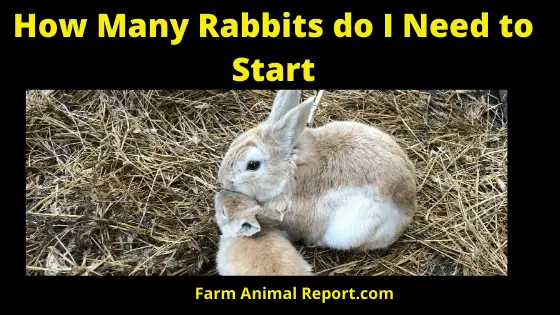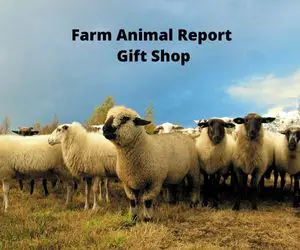As a General rule, You can start rabbit farming by having just one buck, and two does. However, adding another doe or two permits for more diversity.
As a general rule One single doe can produce 25 to 30 young ones. 1) Initial Space requirements are minimal for rabbit farming. 2) Quick returns within six months after the development of the farm. 3) Rabbit is close to white meat. 4) Rabbits are the best producers of wool on a per lb body weight basis. 5) Rabbit farming is suitable to have income through the sale of kits, meat, manure, and pelt. 6) The wool of the rabbit is 6-8 times warmer as compared to the wool of rabbits.
How Many Rabbits do you Need / Rabbit Farming is Attractive
- Rabbit Meat – Lean Very Nutritious and a great alternative to beef and pork
- Rabbit Angora Wool is highly sought after for fabric making
- Rabbit Manure is great for gardens and very nutritious for soils
- Rabbits & Worms – Great complementary business – producing Fishing Worms, Worms for Gardens, Worm Castings for organic farming. Check out Amazon.
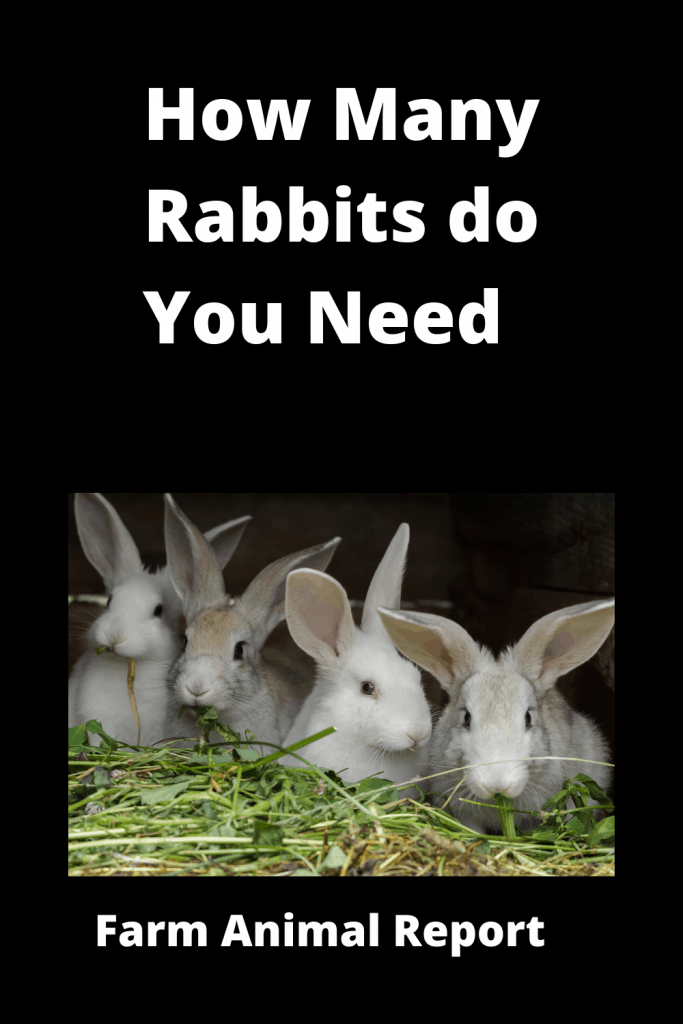
How Many Rabbits do you Need – Rabbits are social creatures, and they don’t like to feel lonely and depressed. They usually travel in pairs and large groups so that they can protect each other from predators. Rabbits can live alone, but this loneliness can make them depressed.
You can also read our Guide –18 Ways to Make Money by Rabbit Farming—Extensive Guidelines for Rabbit Farmers
When I was a Young Man, our family raised a small number of rabbits, for meat. As Kids, we loved the taste of rabbit meat. My brother and I worked along with our dad in raising them.
PDF – Beginning a small Rabbit Farm – Peace Corp
Dad had to go to work each day, so the daily task of feeding and watering fell to us. But I still have fond memories of what I learned taking care of our small farm. It provided all the meat we needed and many other family members were asking for meat also.
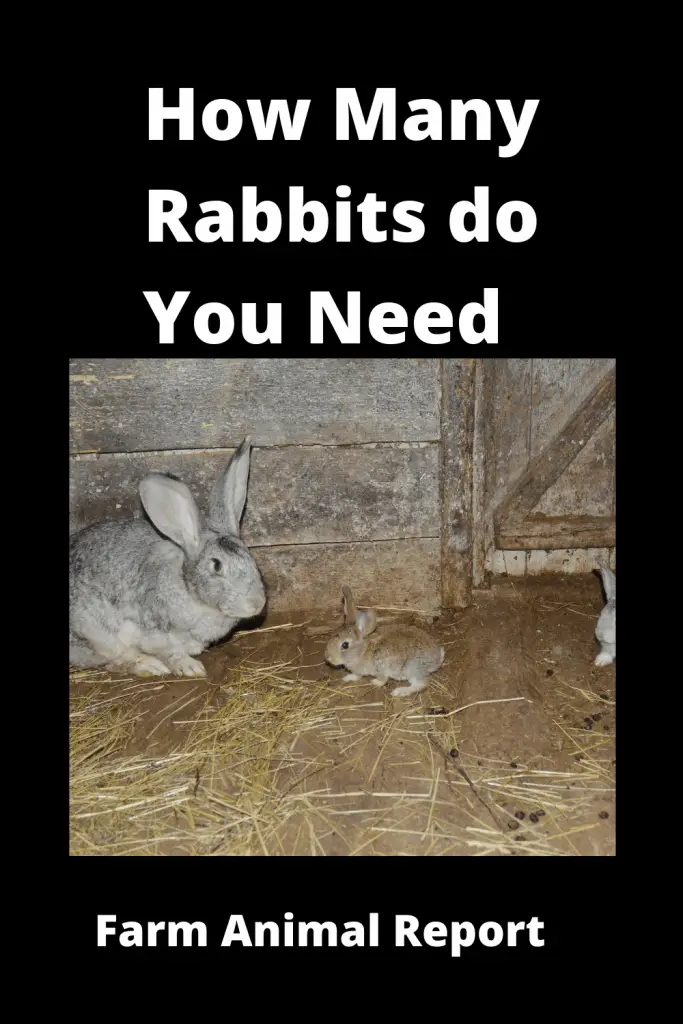
Therefore, it is always worthwhile to keep the rabbits in pairs. It is better to have rabbits that have a stronger bond between them. These bonded rabbits should not be separated, and they need to have a company with each other.
The rabbits are family-friendly animals, and they can be raised as a pet or grow from meat. Rabbits farming is a profitable business. You can start raising rabbits by having a single pair of mature breeder rabbits.
Then, you have to take good care of them. It is not difficult as the rabbit demands less treatment. In Nature, they will give birth at the age of six months. The hutch size is 6-8 young ones.
Rabbit farming is a sustainable way to provide protein-rich quality meat to the family. Rabbit farming needs little space as compared to the cattle farm. Rabbit farming doesn’t require a considerable investment and the profit is significant in rabbit farming.

The dual advantages of rabbit farming are they can be bred for their meat and also their fur and hide can use to make clothes and other products.
Rabbit farming is for anyone who desires has a desire to rear livestock for a living. An individual with not very much land will enjoy this utilizing a small amount of space to begin a farming operation.
PennState – Rabbit Farming Starting Info
There are two systems in raising rabbits. Both systems need a shed or shelter to protect the rabbits from predators and the elements.
FARMING/RAISING METHODS: –
Rabbits can be raised both in the deep litter system and in a cage system. A small shed at the backyard with minimal investment is more than enough for rabbit farming. However, suitable housing or shed is essential for keeping rabbits free from weather conditions, sunlight, rain, and several other predators like dogs or cats.
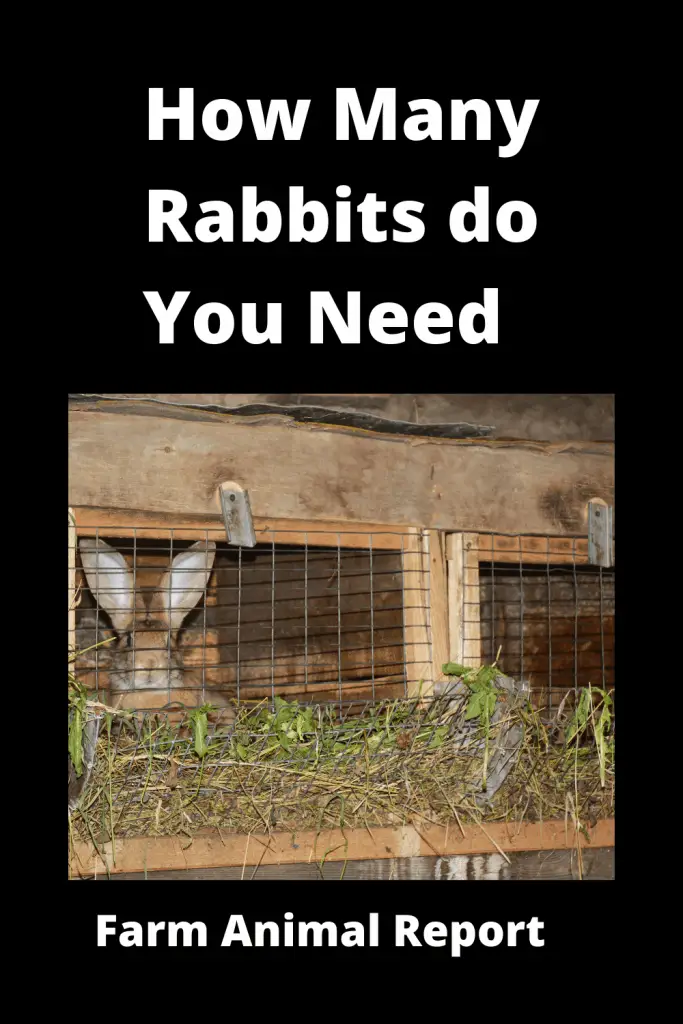
Free-Range System
When You are Raising Free Range Rabbits. You need to have available some type of Rabbit hutches for your rabbits to live in. It can be a pen, a small building with a Roof, Rabbit Hutches are designed for this.
They can return here at night for protection. Some farmers have developed the Bucket Hutch System when doing their free-range rabbits. underground accessible plastic bucket hutches that can replicate a Rabbits burrow.
Deep Litter System
This Literally just as it sounds. You Raise your rabbits in a bed of deep litter using straw or wood shavings. Usually, you have a solid floor, or on dirt and then Change the litter as it gets soiled.
This is good if the housing or pen you have available is in a small shed or building. Some of the problems with this system are
- Rabbits are exposed to living in their Feces and Urine – which raises problems with disease.
- Offers little protection for Infant Rabbits
- Tends to have more fighting
- Hard to manage Breeding
- Feed Contamination is easier
- Repetitive Cost and waste of Litter
- Litter disposal – can become large amounts
- More labor-intensive
Cage System
This is generally often used in Raising rabbits. Wire Cages are suspended 2-3′ above the floor and rabbits are raised in individual pens. Some of the disadvantages are
- Drafts
- Initial Cost
- Foot Damage of living on a wire
Advantages are Many
- Ease of Care
- Cleanliness – Rabbit Urine and feces drop to the floor
- Easier to manage Breeding – Who – When – Where
- Easy to sanitize
- Quick Observation
- Good Predator Protection
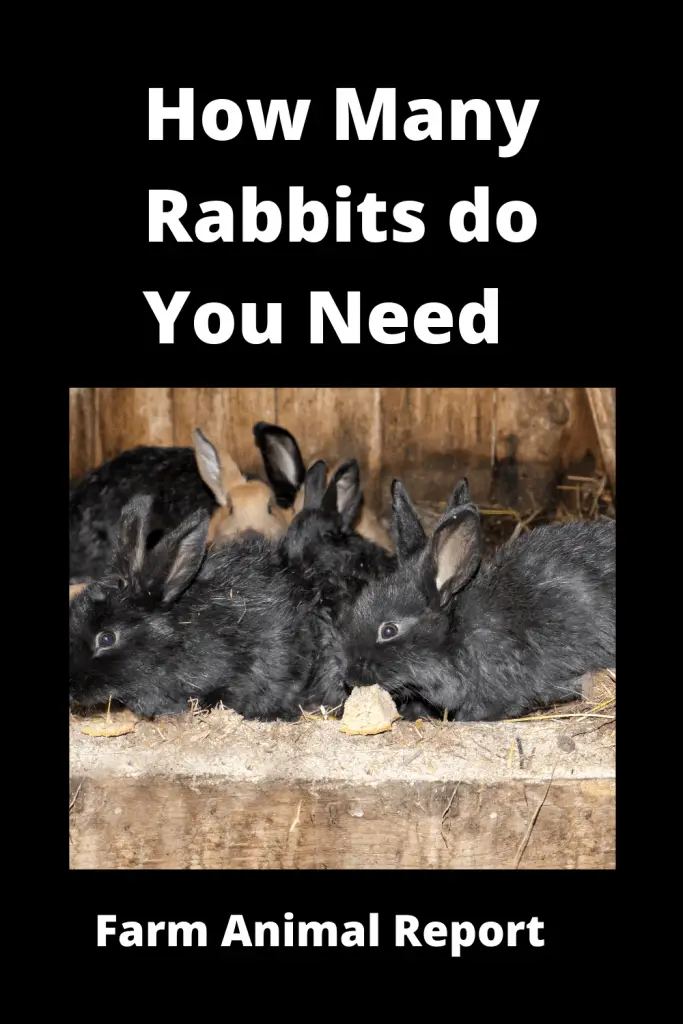
DO RABBITS GET LONELY WITHOUT ANOTHER RABBIT?
Rabbits usually become lonely without the company of another rabbit. Rabbits are hardwired to be social. Rabbits in nature live in large colonies, so the species instinctively seek the company.
Rabbits understand that there is safety in numbers. The more the rabbits live together, the higher the likelihood of predators being spotted. Rabbits have no protection against predators except fleeing or hiding.
WHY IS A SECOND RABBIT A GOOD IDEA?
The need for companionship is so deeply ingrained in rabbits that centuries of domestication have had little impact. Like humans and many other creatures, rabbits need to live in groups.
Rabbits like to cooperate to find food, watch for and warn of hunters, and defend, raise and communicate with their young ones.
The need for the company can be met somewhat by a human, but once you are living with a bonded pair or trio, you will see that even the most devoted human cannot fill the bill. Bonded pairs of rabbits are seldom out of each other’s sight.
Rabbits like to talk with one another regularly, not so much with sounds as with movements. There are significant movements like dancing and grooming, and there are quite small communications of breath and a slight shift in position.
Boredom and depression are the main signs of loneliness n rabbits. These are accompanied by destructiveness and hyperactivity in some rabbits.
RUN A RABBIT FARM – SETUP, BREEDING & MORE
Below is a general guide to acquiring rabbits, setting up your rabbit farm, and raising and breeding your rabbits humanely.
Raising Rabbits can be for a small operation, providing meat for your family. Having just a few breeding rabbits – or growing into large farming operations. Becoming an important source of profits.
Rabbits for Meat
Rabbit Meat Profitability Table
| Rabbits | Rabbits Born | Lbs Meat / Year | Average Price / LB | Total Revenue Possible |
|---|---|---|---|---|
| 1 | 84 | 252 | $ 8.00 | $ 2016 |
| 2 | 168 | 504 | $ 8.00 | $ 4032 |
| 5 | 420 | 1260 | $ 8.00 | $ 10,080 |
| 10 | 840 | 2520 | $ 8.00 | $ 20,162 |
| 20 | 1680 | 5040 | $ 8.00 | $ 40,320 |
| 30 | 2520 | 7560 | $ 8.00 | $ 60,480 |
| 40 | 3360 | 10,080 | $ 8.00 | $ 80,640 |
| 50 | 4200 | 12,600 | $ 8.00 | $ 100,800 |
| 100 | 8400 | 25,200 | $ 8.00 | $ 201.600 |
| 200 | 16,800 | 50,400 | $ 8.00 | $ 403,200 |
Rabbits for Black Gold – Poop
Rabbit Poop Profitability Table
| Number Rabbits | Manure / day / .5lb | Manure / lbs Week | Manure /lbs Year | |
|---|---|---|---|---|
| 1 | .5 | 3.5 | 182 | |
| 2 | 1 | 7 | 364 | |
| 3 | 1.5 | 10.5 | 546 | |
| 4 | 2 | 14 | 728 | |
| 5 | 2.5 | 17.5 | 910 | |
| 10 | 5 | 35 | 1820 | |
| 20 | 10 | 70 | 3640 | |
| 30 | 15 | 105 | 5460 | |
| 40 | 20 | 140 | 7280 | |
| 50 | 25 | 175 | 9100 | |
| 100 | 50 | 350 | 18,200 | |
| 200 | 100 | 700 | 36,400 | |
Rabbits for Wool
Rabbit Giant Angora Fur Profitability Table
| Rabbits | Rabbits Born / Yr | 0z wool / Year 40 OZ / Rabitt | Average Price / oz $10.00 | Feed Cost / Yr $ .30 per day / $ 110 per Year | Total Revenue Possible |
|---|---|---|---|---|---|
| 1 | 84 | 3,360 | $ 33,600 | $ 9,240 | $ 24,360 |
| 2 | 168 | 6,720 | $ 67,200 | $ 18,480 | $ 48,720 |
| 5 | 420 | 16,800 | $ 168,000 | $ 46,200 | $ 121,800 |
| 10 | 840 | 33,600 | $ 33,6000 | $ 92,400 | $ 243,600 |
| 20 | 1680 | 67,200 | $ 672,000 | $ 184,800 | $ 487,200 |
| 30 | 2520 | 100,800 | $ 1,008,000 | $ 57,200 | $ 950,800 |
| 40 | 3360 | 134,400 | $ 1,344,000 | $ 369,600 | $ 974,400 |
| 50 | 4200 | 168,000 | $ 1,680,000 | $ 462,000 | $ 1,218,000 |
| 100 | 8400 | 336,000 | $ 3,360,000 | $ 924,000 | $ 2,436,000 |
| 200 | 16,800 | 672,000 | $ 6,720,000 | $ 1,848,000 | $ 4,872,000 |
Average Giant Angora Weight 10lb
40 Oz shaved Fur per Rabbit per Year
Feed $ .30 per day for 10lb Rabbit
Plan Your Colony.
Initially, it is essential to decide the herd size and breed of the rabbit. You can start a rabbit farming by having just one buck, and two does. However, adding another doe or two permits for more diversity.
- Plan Your Hutch and Run.
Look for a pre-built hutch or hutch plan with sufficient room for your herd, keeping in mind that you’re going to have a lot more rabbits on your hands soon.
The hutch plans and description of the product generally spell out capacity. You should ensure that your backyard should have enough space, and should have a suitable location for the whole thing.
- Build or Install Your Hutch and Run.
After having all the permission from the authorities, try to set up the rabbit’s future home. If the prospect of building a DIY hutch is overwhelming, tap a handy friend or family member to lend a hand.
- Get the Space Ready for Your Rabbits.
After having everything done for the rabbits to make sure that they are safe, healthy, and comfortable with adequate food and water containers, hay and pellets, bedding, and sanitation equipment. Make sure that everything is clean and clear for the rabbits.
- Purchase Your Rabbits.
Once everything is ready for the rabbits, purchase the rabbits from the breeder. Don’t just wait to have a pedigreed rabbit with papers. Start with the best option available near to you. This will allow you to rely on Their Experience as you begin Your Farm.
- Get Into a Rhythm.
Get into a feeding and cleaning pace that line up with your rabbits’ habits and your schedule. Every herd is dissimilar – and, as your rabbit population grows, your responsibilities will change. Rabbits are very prolific breeders, so your Colony size can grow quickly
Remember, does are eternally fertile, so don’t mix genders until you are ready for the results. If there is more than one male rabbit, use a spreadsheet to track which female rabbit will mate with and the generational lines that result.
The female rabbit will start to pull out her hair and to add hair to the bedding in the nursing room is a sign that the doe is about to give birth—rabbits born blind and helpless.
The mother will feed the young ones twice a day. Just have a check and balance to make sure that the babies are still alive. It is common for the mother to lose a few of their first litter. Try to use gloves while handling the baby rabbits, as their immune system is just developing and they are initially hairless.
- Let the Litter Grow.
Once the baby rabbits surviving members are weaned, let them do their things for a few weeks. For the majority of breeds, four to six pounds in the ideal fryer size. More massive than four to six pounds the meat is too gamey, small than that and you don’t get enough.
- Rinse and Repeat
A mature and healthy doe on a fast, safe breeding schedule can produce 200 to 250 pounds of meat per year. As long as you are willing to keep the cycle going, your rabbits will keep the family well-fed.
Main Advantages of Rabbit Farming:
- One single doe can produce 25 to 30 young ones.
- Initial Space requirements are minimal for rabbit farming.
- Quick returns within six months after the development of the farm.
- Rabbit meat is categorized as white meat.
- Rabbits are the best producers of wools on per lb body weight basis.
- Rabbit farming is suitable to have income through the sale of kits, meat, manure, and pelt.
- The wool of the rabbit is 6-8 times warmer as compared to the wool of rabbits.
- It is easy to rear rabbits on roughages with a very less quantity of costly concentrate food.


